

|
THERMO K click (Thermocouple) Released

THERMO K click carries the MCP9600 IC from Microchip. Depending on the type of probe it uses the click can measure temperatures from -200 °C to +1372 °C.
The click is designed to run on either a 3.3V or 5V power supply. It communicates with the target MCU via an I2C interface.
|
2017/01/15 |

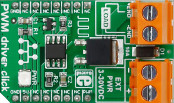
|
PWM Driver click Released

PWM Driver click can be used to control DC motors with loads of up to 10A, via the on-board Silicon Lab Si8711CC one-channel isolator.
|
2017/01/15 |

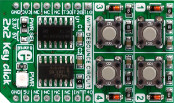
|
2x2 Key click Released

2x2 Key click has a 4 button keypad. The click allows multiple key presses and has a debounce circuit composed of 74HC32 quad 2-input OR gate from NXP and the SN74HC14 Hex Schmitt-Trigger Inverter from Texas Instruments. 2x2 Key click is designed to use either 3.3V or 5V power supply. The buttons can be independently read.
|
2017/01/15 |


|
FLICKER click Released

FLICKER click toggles a relay on and off at time intervals which are adjustable with the on-board potentiometers. It is a simple solution if you need to turn a device on and off at specific time intervals, like blinking LED commercials, alarm system lights, or any other signalling lights.
|
2017/01/15 |


|
ATA663211 click (LIN) Released

ATA663211 click carries an Atmel LIN transceiver IC designed to handle low-speed data communication in vehicles and in industrial applications with electrically harsh environments. The LIN connection is established by attaching wires to the onboard screw terminals.
|
2017/01/15 |


|
GSM4 click Released

GSM 4 click is a mikroBUS™ add-on board that features the u-blox SARA-G3 series 2.5G GSM/GPRS cellular quad-band module. The SARA-G3 module has a miniature LGA (Land Grid Array) form factor as well as an RF transceiver and a power amplifier.
|
2017/01/15 |


|
BT Audio click Released

BT Audio click features Microchip's RN52 Bluetooth audio module. With onboard 3.5mm jacks for both a microphone and a speaker, this is a complete solution for streaming audio from a smartphone or PC over a wireless connection.
|
2017/01/15 |

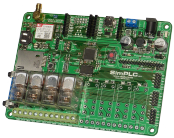
|
SimPLCv2 now with PIC18F47J53

Our SimPLCv2 boards now come with a PIC18F47J53 microcontroller, featuring twice as much FLASH memory as the PIC18F46J50 used on the original boards!
|
2017/01/03 |


|
Brushless click Released

Brushless click carries Toshiba's TB6575FNG IC for driving 3-phase full-wave Brushless DC motors - which are ideal for powering flying drones. The click is able to safely drive external motors with up to 32V/2A.
The board features three pairs of onboard screw terminals. VBAT is for connecting an external 7-32V DC power supply. The other two are for connecting an external motor.
|
2016/11/19 |

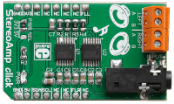
|
StereoAmp click Released

StereoAmp click functions as a stereo amplifier and is ideal for battery operated devices or as a lab amplifier. It features two LM48100Q-Q1 Boomer single supply, mono, bridge-tied load amplifier ICs by Texas Instruments. The LM48100Q-Q1 has output fault detection and I2C volume control.
The StereoAmp click features a 3.5mm input jack and four output screw terminals for connecting passive speakers. It runs on either 3.3V or 5V power supply and communicates with the MCU through the I2C interface.
|
2016/11/19 |

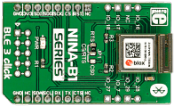
|
BLE3 click (BlueTooth) Released

BLE 3 click is a quick and simple solution if you want to add Bluetooth Low Energy to your project. It features the NINA-B1 Bluetooth 4.2 module, from u-blox. This click also comes with an integrated antenna mounted on the PCB.
|
2016/11/09 |


|
NFC click Released

NFC click is a mikroBUS add-on board with a versatile near field communications controller from NXP - the PN7120 IC. NFC devices are used in contactless payment systems, electronic ticketing, smartcards, but also in retail and advertising - inexpensive NFC tags can be embedded into packaging labels, flyers or posters.
This board has full compliancy with NFC Forum specifications which means that you will be able to use the full potential of NFC and its three distinct operating modes:
1. Card emulation
2. Read/Write
3. P2P
In other words, NFC click can be set to behave either as an NFC reader, or a tag, or to establish a two-way connection with another NFC device.
|
2016/11/09 |


|
mikroMedia 7" for STM32F7 Released

Mikromedia 7 for STM32F7 is a 7" display board powered by the proven STM32F746ZG with 216 MHz operation (462 DMIPS), 1 MB of Flash and 320 + 4 KB of SRAM. The board also features various modules such as an accelerometer, microSD card slot for external storage, MP3 Stereo Codec chip, WiFi module, CAN interface and ethernet connector.
|
2016/11/03 |


|
OLED Switch click Released

If you are building any type of human machine interface, OLED Switch click can help you keep the design simple, clear and interactive. It can be used in designing a control panel for an industrial machine... or a DIY arcade.
This board has a module that combines a button and a full color organic LED display, plus input/output screw terminals for connecting an external circuit (to toggle it on and off).
The mechanical button itself is nicely built, with a translucent black housing. When pressed, it gives satisfying tactile feedback.
The display, built in the button itself, can show 64 by 48 pixel images with up to 65k colors (16-bit depth).
|
2016/11/01 |


|
ECG click Released

This is an ECG (or EKG) machine on a click board. It measures the electrical activity of a beating heart through electrodes taped to the skin. The board requires little setup, and the final measurement results can be displayed as an electrocardiogram using a free Windows app.
With the ECG click bundle (click + cable + electrodes) you will be able to prototype your own health-tracking and fitness devices, quantified-self wearable or you can just make an LED blink in sync with your heart.
|
2016/11/01 |


|
CC3100 click (WiFi) Released

If you are building an IoT device that connects to the internet through WiFi, your two biggest concerns are power consumption and security – both major strengths of the module onboard CC3100 click.
This WiFi click board carries the successor of the highly popular CC3000 module from Texas Instruments. Its claim to fame was that it simplified WiFi for embedded developers by integrating multiple Internet Protocols and a Wifi driver with a simple API.
CC3100 inherits all these benefits, and on top of that, adds an updated protocol stack (support for 802.11n) and cutting edge security features (TSL encryption, hardware crypto-engine and more).
|
2016/11/01 |


|
VREG click Released

VREG click is a digitally controlled DC Voltage regulator in mikroBUS™ form factor. The design is based on the well-known LM317 circuit, with the addition of a 12-bit DAC, 12-bit ADC, and an Operational Amplifier. Two pairs of screw terminals serve as inputs and outputs.
The LM317 IC is a reliable regulator with typical line regulation of 0.01% and load regulation of 0.1%. It also has internal short-circuit current limiting and thermal overload protection.
The circuit regulates voltage by turning all input/output difference into heat (effectively dissipating all the excess power). If it gets too hot it may damage the board or cause unexpected behaviour.
Because of that, the board’s operating range is defined by two factors. 1) maximum input voltage and current (should not exceed 20V/1A); and 2) maximum wattage arising from current and I/O voltage difference (should not exceed 2W, measured as I x (Input V - Output V).
The board also carries a MOSFET chip to toggle the output on and off.
VREG click communicates with the target board MCU through the SPI interface (CS, SCK, MISO, MOSI). The board can use either a 3.3V or a 5V power supply.
It is also possible to use the board’s power supply as the Input, by resoldering the onboard INPUT SEL jumper.
|
2016/11/01 |

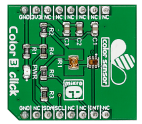
|
Color 3 click Released

Color 3 click is a mikroBUS add-on board with a TCS3771 color sensor (also known as a light-to-digital converter) and a narrow beam Infrared LED. The circuit can also function as a proximity sensor.
TCS3771 is a RGBC sensor: it can detect Red, Green, Blue and clear light. The IC performs well under a variety of lighting conditions. For example, it can be covered with different attenuation materials.
As a proximity sensor it has a large dynamic range of operation. It can take short distance measurements behind dark glass; or it can be configured for longer distance measurement, for example, human presence detection in front of monitors or laptops.
For power-saving, TCS3771 has an internal state machine that can put the device into a low power mode between successive RGBC and proximity measurements.
TCS3771 is also fast enough to give off proximity information at a high rate of repetition. This makes it useful for proximity detection in portable devices (such as a phone coming near to a speaker’s ear).
Color 3 click communicates with the target MCU through the mikroBUS I2C interface, with additional functionality provided by an INT pin. Designed to use a 3.3 power supply only.
|
2016/11/01 |

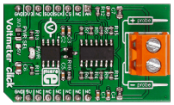
|
Voltmeter click Released

Voltmeter click is a mikroBUS add-on board for measuring voltage in an external electric circuit.
The board is designed to measure Direct Current only, and has a measurement range from 0 to 24V (it's possible to measure both positive and negative charges).
The design of the board is based on an OpAmp set up as a differential amplifier with a buffered input.
Two onboard screw terminals (probe+ and probe-) are bringing in the current, which then flows through a row of four resistors. A voltage – proportional to the input charge – is generated across the last two resistors. From there it is sent to the differential amplifier that further intensifies the difference between the two inputs (+/-).
The resulting charge is exactly 33 times lower than the actual measured voltage. It is converted by an onboard 12-bit ADC before being outputted through the mikroBUS SPI interface (the firmware in the target board MCU should be set up to multiply the ADC value to get the actual voltage). It is also possible to output the analog value directly through the mikroBUS AN pin (useful if the target MCU has a higher resolution ADC).
The board can work with either a 3.3V or a 5V power supply.
|
2016/11/01 |


|
3G SARA click Released

3G SARA click is a mikroBUS add-on board with the smallest UMTS/HSPA cellular modem available today - the u-blox U201, from the award-winning SARA series.
The board has everything you need to add 3G to your devices and make them respond and react to phone calls and messages - or send/receive data at speeds up to 7.2 Mb/s - from anywhere in the world. The code example provided should help you get started quickly.
|
2016/11/01 |

|

